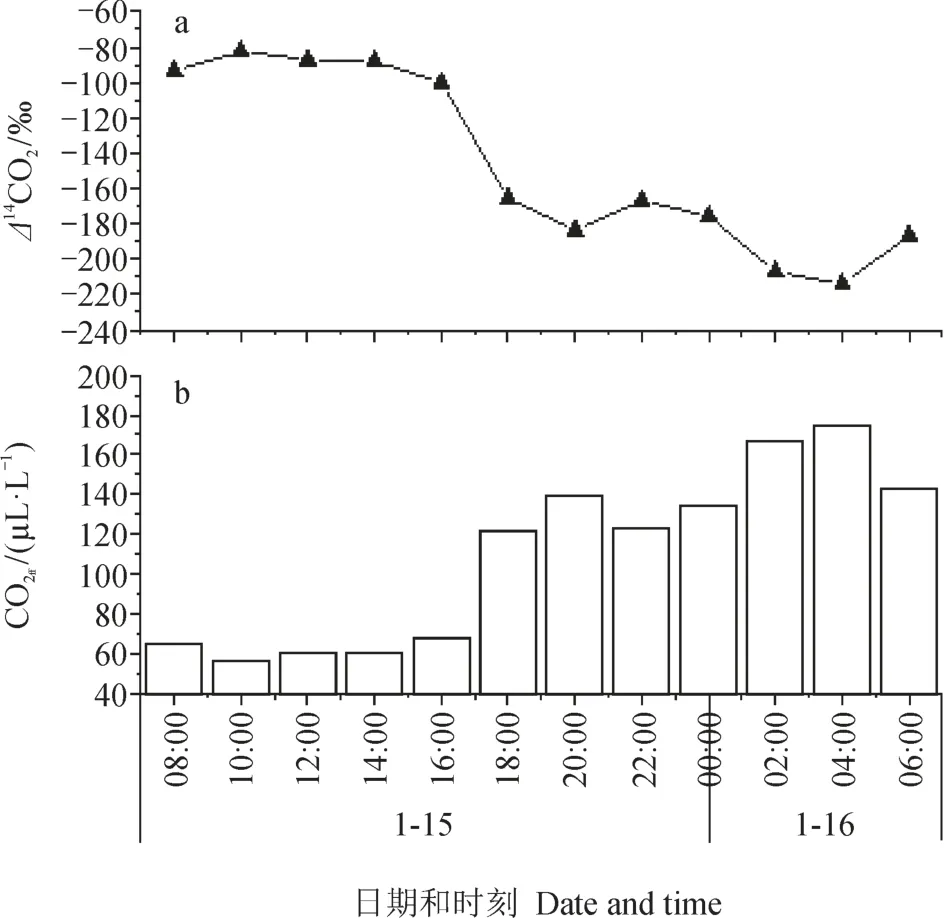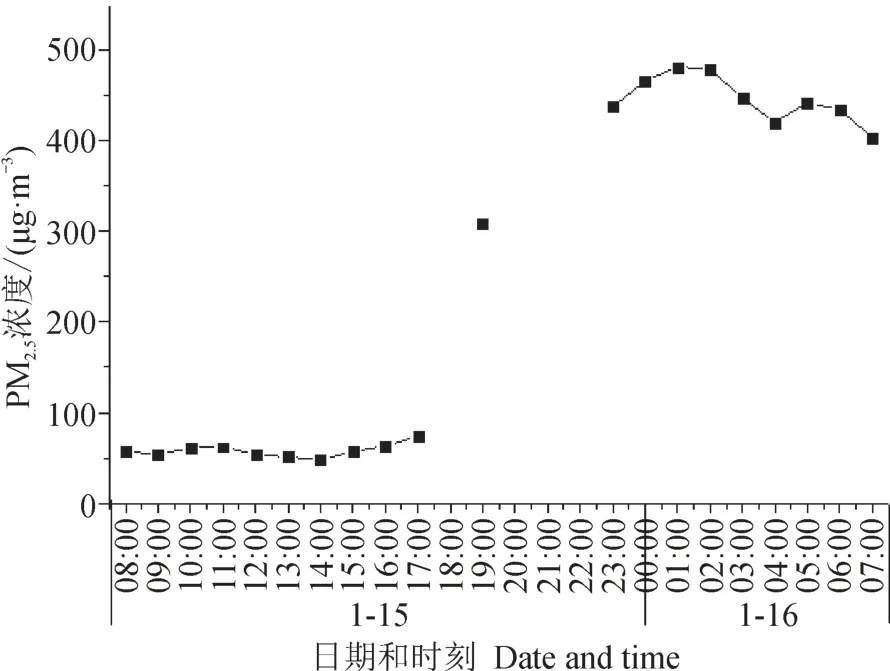北京市冬季大气化石源CO2典型日变化的14C示踪研究
牛振川,周卫健,,程 鹏,吴书刚,卢雪峰,杜 花,付云翀,熊晓虎
(1. 中国科学院地球环境研究所 黄土与第四纪地质国家重点实验室,陕西省加速器质谱技术及应用重点实验室,西安 710061;2. 西安加速器质谱中心,西安 710061;3. 北京师范大学,北京 100875)
北京市冬季大气化石源CO2典型日变化的14C示踪研究
牛振川1,2,周卫健1,2,3,程 鹏1,2,吴书刚1,2,卢雪峰1,2,杜 花1,2,付云翀1,2,熊晓虎1,2
(1. 中国科学院地球环境研究所 黄土与第四纪地质国家重点实验室,陕西省加速器质谱技术及应用重点实验室,西安 710061;2. 西安加速器质谱中心,西安 710061;3. 北京师范大学,北京 100875)
城市作为化石源CO2()排放的热点区域,获得其大气浓度的日变化特征对于深刻理解城市地区的时空变化规律,进而制定合理的节能减排政策至关重要。本研究通过AMS-14C技术,示踪了北京市冬季一个典型日变化事件中大气的变化过程,并探讨了其影响因素。本次日变化事件中大气δ13CO2的值为(-13.9 ± 0.8)‰(-14.8‰ — -12.7‰),Δ14CO2的值为(-151.6 ± 51.3)‰((-214.2 ± 2.9)‰ — (-82.3 ± 3.0)‰),浓度为104.4 ± 44.0 μL · L-1(168.6 ± 2.7 — 52.1 ± 3.2 μL · L-1)。浓度具有较大的日变化,夜晚浓度明显高于白天,主要是由于夜间大气混合层高度较低、供暖消耗更多的化石燃料以及在东南风条件下因北京不利的扩散条件而使聚积。此外,在早晚高峰期间,观察到由于交通流量增加引起的较高浓度。同期PM2.5浓度相似的日变化过程进一步验证了本次观测结果的可靠性。
化石源CO2;14C示踪;北京;日变化;冬季
南极冰芯的记录显示,最近80万年以来大气CO2浓度与温度同步变化(Lüthi et al,2008)。近代工业革命以来,由于化石燃料的大量使用使得大气CO2浓度由280 μL · L-1上升到目前的400 μL · L-1左右,全球温度上升了0.74℃(IPCC,2007;GMD ESRL,2014)。由此,国际社会普遍认为有很大可能性,全球变暖是由于化石源CO2()等温室气体排放造成的(Rosa and Ribeiro,2001;丁仲礼等,2009)。为了应对气候变暖,碳减排已成为了全球共识。作为CO2的排放大国(Gregg et al,2008)和《京都议定书》的缔约国,我国面临越来越大的国际减排压力。如何科学、准确、有效地评估我国目前大气排放现状,不仅是一个亟待解决的环境外交问题,而且是一个重要的科学问题(牛振川等,2014)。
1 采样与分析方法
1.1 采样地点
采样点(40.01° N,116.35° E)位于北京市海淀区中国科学院生态环境研究中心一科研楼顶(15 m),周边区域主要为住宅、商业、办公、高校和公园等,是北京市城市点的典型代表。该地点位于北四环和五环之间,离绕城高速和京藏高速的直线距离超过1 km,离交通干道500 m和街道100 m以上,周边无直接污染源。
1.2 采样时间与方法
本次样品采集从2014年1月15日早上8:00开始,每隔2小时采集1次样品,一直到次日早上6:00结束,以此作为冬季日变化的典型代表。采样前先用当地空气冲洗5 min,然后将气体样品通过气泵采集到5 L铝箔气袋(中国,大连德霖)内,开关阀门时屏住呼吸,采样时气袋远离操作者,并记录采样时相关的气象参数信息。然后将气袋包装后迅速送回实验室进行相关分析。
1.3 样品CO2浓度和δ13CO2的分析方法
样品CO2浓度由Picarro G2131-i型CO2碳同位素分析仪(Picarro公司,美国)测定。Picarro采用光腔衰荡光谱技术(CRDS),具有线性好、精度高的优点(Crosson,2008;Chen et al,2010)。CO2的测量精度为0.1 μL · L-1。每个样品测试6分钟,为减少因换样给仪器带来的死体积影响,仅后4分钟的测试数据用于CO2浓度计算,将12和13的浓度相加得到样品的CO2浓度。同时,计算后4分钟样品δ13C的平均值,δ13C的定义为:

1.4 样品14C分析方法
将气袋内的气体缓慢释放到真空纯化系统后,通过低温液氮冷阱(-196°C)和液氮+酒精冷阱(-90°C)将样品纯化后,再经Zn-Fe法(Slota et al,1987)将纯化的CO2还原成石墨,压靶后在西安加速器质谱中心的3 MV多核素分析用加速器质谱仪(Accelerator mass spectrometer,AMS)(HVEE,荷兰)上进行14C测定,14C测量的精度在3‰左右,并用AMS得到的δ13C进行Δ14C的分馏校正。
样品14C的含量通常用Δ14C表示,其定义为(Stuiver and Polach,1977):

(14C/12C)SN是指样品经过δ13C分馏校正和放射性衰变校正后的14C/12C 的比值,(14C/12C)abs是指绝对国际放射性碳标准的14C/12C的比值。


公式(5)中等号右边的第二项(β)可以写为:

2 结果与分析
2.1 本底点大气Δ14CO2值
本底点Δ14CO2值对的计算结果影响较大,最佳的本底点应为自由对流层,但在自由对流层开展长期观测有一定的难度,因此常用高山本底点来代替自由对流层(Turnbull et al,2009)。目前最新公开发表的Δ14CO2本底数据是2011年的Jungfraujoch站(Levin et al,2013),约为37‰;但缺乏公开发表的2014年Δ14CO2本底值。基于本底站Δ14CO2的值每年下降约5‰(Graven et al,2012),本文选用22‰作为2014年的本底值。但值得注意的是,由于高山本底点受当地或区域化石源排放的影响,其Δ14CO2值与自由对流层会有2‰ — 3‰差别,这会给的计算结果带来0.8 μL · L-1左右的误差。
2.2 大气CO2浓度的日变化
本次日变化事件中,观测点大气CO2浓度的日均值为508.0 ± 38.9 μL · L-1。大气CO2浓度从10:00的最低值476.1 μL · L-1变化到04:00的最高值535.1 μL · L-1;夜晚大气CO2浓度要比白天高约60 μL · L-1;且白天大气CO2浓度在08:00也较高(476.1 μL · L-1)。大气CO2浓度具有较大日变化,下文将对造成其变化的因素进行分析。
2.3 大气δ13CO2的日变化
本次日变化事件中,大气δ13CO2值的变化范围为-14.8‰ — -12.7‰,均值为(-13.9 ± 0.8)‰,显著高于瓦里关本底点的大气δ13CO2值(-8.5 ± 0.2)‰(GMD ESRL,2014)。较低的城市大气δ13CO2值主要是由于13C更“贫化”(平均值约-28‰)的化石燃料大量使用造成的。且白天的δ13CO2值(-13.1 ± 0.3)‰显著(p < 0.05)高于晚上(-14.5 ± 0.3)‰,这可能跟夜晚取暖使用更多的化石燃料有关。
如图1a所示,采样点大气Δ14CO2的变化范围为(-214.2 ± 2.9)‰— (-82.3 ± 2.5)‰,均值为(-145.8 ± 51.3)‰。将样品Δ14CO2值和CO2浓度、本底Δ14CO2值以及β校正代入公式(5)得到样品浓度。采样点大气浓度的日均值为104.4 ± 40.0 μL · L-1,变化范围为52.1—168.6 μL · L-1。与瓦里关本底大气CO2浓度(399.6 ± 4.2 μL · L-1)(GMD ESRL,2014)相比,浓度占新增大气CO2浓度的(93.6 ± 4.5)%;且浓度和大气CO2浓度高度相关(R2= 0.99,p< 0.01),这表明采样点大气CO2浓度的日变化主要是由于化石源排放造成的。

图1 北京市冬季大气Δ14CO2(a)和(b)的典型日变化状况Fig.1 One typicalΔ14CO2(a) and(b) diurnal variations during wintertime in Beijing
限于14C较高的分析成本,本次日变化事件仅在北京市的一个采样点开展观测工作。那么,此采样点观测到的数据是否具有代表性,是否受到局地排放源的影响以及是否反映了整个北京市此次日变化的真实状况?为此,我们分析了北京市同期大气PM2.5浓度的变化状况(图2),PM2.5浓度为北京市8个站点的平均值。进行PM2.5浓度分析的原因是基于化石源排放是北京以及我国众多城市PM2.5的重要来源(白春礼等, 2014),PM2.5的变化应与相关联。从图2可以明显地看出,北京市同期大气PM2.5浓度与大气具有相似的变化规律,这间接地验证了本文观测结果的可靠性。

图2 同期北京市大气PM2.5浓度的变化状况(数据来自http://www.aqistudy.cn/)Fig.2 The hourly PM2.5concentrations on a typical wintertime diurnal event in Beijing (Data is obtained from the website: http://www.aqistudy.cn/)
3 结论
参考文献
白春礼. 2014. 中国科学院大气灰霾研究进展及展望[J].中国科学院院刊, 29(3): 275–281. [Bai C L. 2014. Progress and prospect on atmospheric haze research in Chinese Academy of Sciences [J].Bulletin of Chinese Academy of Sciences, 29(3): 275–281.]
丁仲礼, 段晓男, 葛全胜, 等. 2009. 2050年大气CO2浓度控制: 各国排放权计算[J].中国科学D辑: 地球科学, 39(8): 1009–1027. [Ding Z L, Duan X N, Ge Q S, et al. 2009. Control of atmospheric CO2concentration by 2050: An allocation on the emission rights of different countries [J].Science China Series D-Earth Science, 39(8): 1009–1027.]
牛振川, 周卫健, 吴书刚, 等. 2014. 大气14CO2的时空分异特征及其在化石源CO2示踪中的应用[J].地球环境学报, 5(1): 1–5. [Niu Z C, Zhou W J, Wu S G, et al. 2014. Spatial-temporal characteristics of atmospheric14CO2and its applications on the tracing of fossil fuel CO2[J].Journal of Earth Environment, 5(1): 1–5.]
Chen H, Winderlich J, Gerbig C, et al. 2010. High-accuracy continuous airborne measurements of greenhouse gases (CO2and CH4) using the cavity ring-down spectroscopy (CRDS) technique [J].Atmospheric Measurement Techniques, 3: 375–386.
Ciais P, Paris J D, Marland G, et al. 2010. The European carbon balance. Part 1: Fossil fuel emissions [J].Global Change Biology, 16: 1395–1408.
Crosson E R. 2008. A cavity ring-down analyzer for measuring atmospheric levels of methane, carbon dioxide, and water vapor [J].Applied Physics B, 92: 403–408.
Duren R M, Miller C E. 2012. Measuring the carbon emissions of megacities [J].Nature Climate Change, 2: 560–562.
Global Monitoring Division of the Earth System Research Laboratory (GMD ESRL). 2014. National Oceanic and Atmospheric Administration, U.S. Department of Commerce [DB]. ftp://aftp.cmdl.noaa.gov/data/trace_ gases/co2/flask/surface/co2_wlg_surface-flask_1_ccgg_ month.txt
Godwin H. 1962. Half-life of radiocarbon [J].Nature, 195: 984.
Graven H D, Guilderson T P, Keeling R F. 2012. Observations of radiocarbon in CO2at seven global sampling sites in the Scripps flask network: Analysis of spatial gradients and seasonal cycles [J].Journal of Geophysical Research, 117: D02303, doi: 10.1029/2011JD016535.
Gregg J S, Andres R J, Marland G. 2008. China: emissions pattern of the world leader in CO2emissions from fossil fuel consumption and cement production [J].Geophysical Research Letters, 35: L08806,doi:10.1029/2007GL032887.
Intergovernmental Panel on Climate Change (IPCC). 2007. Climate change 2007: the physical science basis. summary for policymakers [R]. Paris: Working GroupⅠto the Fourth Assessment Report of IPCC.
Levin I, Kromer B, Schmidt M, et al. 2003. A novel approach for independent budgeting of fossil fuel CO2over Europe by14CO2observations [J].Geophysical Research Letters,30(23): 2194, doi:10.1029/2003GL018477.
Levin I, Karstens U T E. 2007. Inferring high-resolution fossil fuel CO2records at continental sites from combined14CO2and CO observations [J].Tellus, 59B: 245–250.
Levin I, Kromer B, Hammer S. 2013. AtmosphericΔ14CO2trend in Western European background air from 2000 to 2012 [J].Tellus B, 65: 20092, doi:10.3402/tellusb. v65i0.20092.
Lüthi D, Floch M L, Bereiter B, et al. 2008. High-resolution carbon dioxide concentration record 650,000— 800,000 years before present [J].Nature, 453: 379–382.
Marland G. 2008. Uncertainties in accounting for CO2from fossil fuels [J].Journal of Industrial Ecology, 12: 136–139.
Marland G, Boden T A, Andres R J, et al. 2003. Global, regional, and national fossil fuel CO2emissions [M]// Carbon Dioxide Information Analysis Center, Oak Ridge National Laboratory, US Department of Energy. Trends: a compendium of data on global change. Tennessee: 34–43.
Miller J B, Lehman S J, Montzka S A, et al. 2012. Linking emissions of fossil fuel CO2and other anthropogenic trace gases using atmospheric14CO2[J].Journal of Geophysical Research, 117: D08302,doi:10.1029/2011JD017048.
Rakowski A Z, Nakamura T, Pazdur A. 2008. Variations of anthropogenic CO2in urban area deduced by radiocarbon concentration in modern tree rings [J].Journal of Environmental Radioactivity, 99: 1558–1565.
Rosa L P, Ribeiro S K. 2001. The present, past, and future contributions to global warming of CO2emissions from fuels [J].Climatic Change, 48: 289–308.
Slota P, Jull A T, Linick T, et al. 1987. Preparation of smallsamples for14C accelerator targets by catalytic reduction of CO [J].Radiocarbon, 29: 303–306.
Stuiver M, Polach H A, 1977. Discussion: reporting of14C data [J].Radiocarbon, 19: 355–363.
Takahashi H A, Konohira E, Hiyama T, et al. 2002. Diurnal variation of CO2concentration,Δ14C andδ13C in an urban forest: estimate of the anthropogenic and biogenic CO2contributions [J].Tellus, 54B: 97–109.
Turnbull J C, Miller J B, Lehman S J, et al. 2006. Comparison of14CO2, CO, and SF6as tracers for recently added fossil fuel CO2in the atmosphere and implications for biological CO2exchange [J].Geophysical Research Letters, 33: L01817, doi:10.1029/2005GL024213.
Turnbull J C, Sweeney C, Karion A, et al. 2015. Toward quantification and source sector identification of fossil fuel CO2emissions from an urban area: Results from the INFLUX experiment [J].Journal of Geophysical Research, 120,doi:10.1002/2014JD022555.
Turnbull J, Rayner P, Miller J, et al. 2009. On the use of14CO2as a tracer for fossil fuel CO2: quantifying uncertainties using an atmospheric transport model [J].Journal of Geophysical Research, 114: D22302, doi:10.1029/2009JD012308.
Zondervan A, Meijer H A J, 1996. Isotopic characterisation of CO2sources during regional pollution events using isotopic and radiocarbon analysis [J].Tellus, 48B: 601–612.
Tracing a typical diurnal variations in atmospheric fossil fuel CO2using radiocarbon during wintertime at an urban site in Beijing
NIU Zhenchuan1,2, ZHOU Weijian1,2,3, CHENG Peng1,2, WU Shugang1,2, LU Xuefeng1,2, DU Hua1,2, FU Yunchong1,2, XIONG Xiaohu1,2
(1. State Key Laboratory of Loess and Quaternary Geology, Shaanxi Key Laboratory of Accelerator Mass Spectrometry Technology and Application, Institute of Earth Environment, Chinese Academy of Sciences, Xi’an 710061, China; 2. Xi’an AMS Center, Xi’an 710061, China; 3. Beijing Normal University, Beijing 100875, China)
Background, aim, and scopeAs the main greenhouse gas, how much of the increased atmospheric CO2derived from the fossil fuel emissions is not only an environmental issue, but also an important scientific question. Traditional statistical methods for estimatingthe magnitude ofemissions incur some uncertainties, especially at regional scale. Radiocarbon (14C), a unique tracer, can be used to distinguish between atmosphericand CO2from other sources, and have been used to infer the spatio-temporal variations of atmosphericin recent years. Cities as emission hotspots, the diurnal atmospheric14CO2observation are important to the understanding of temporal atmospheric fossil fuel CO2() variability, thus facilitating the mitigation strategies ofemissions in China. In this study, one typical diurnal atmospheric14CO2observation was carried out at an urban site in Beijing, with the objective to trace the diurnalvariations, and to determine the factors in fl uencing them.Materials and methodsBeijing, a typical inland city, was selected in this study. It is the most central city in the Beijing-Tianjin-Hebei metropolitan region, with a population of more than 20 million. The city is surrounded by mountains in the west and north and faces the North China Plain to the south. The air sampling site is located on the roof of a building at the Research Center for Eco-Environmental Sciences, Chinese Academy of Sciences, Haidian District. The site is located between the North 4th and 5th Ring roads, surrounded by dense of fi ce and commercial areas, residential districts, universities and parks. Air samples were collected in aluminum foil sampling bags every 2 hours from 8:00 am (local time) on 15th to 6:00 am (local time) on 16th in January, 2014. The CO2concentrations andδ13CO2in the air samples were measured using a Picarro G2131-I CO2Isotopic Analyzer (Picarro Inc., USA) with cavity ring down spectroscopy (CRDS). This equipment is highly linear and very stable, with very precise CO2measurements. Each sample was measured for 6 min, and only the average of the data from the last 4 min was used. The air samples in the bags were transferred to a high vacuum system with liquid nitrogen cold trap (-196 °C) and ethanol-liquid nitrogen cold trap (-90 °C) to get purified CO2, and then converted into graphite using the zinc-iron method. The14C levels of the air samples were measured using a 3 MV AMS in Xi’an, China, with a precision of 2‰—3‰ for14C measurement. The values of14C in the air samples were expressed asΔ14C, i.e., the per mil (‰) deviation from the absolute radiocarbon reference standard corrected by the convention of fractionation and decay.concentrations were calculated according to the mass balance of CO2and14C.ResultsThe CO2concentration in the diurnal event was 508.0 ± 38.9 μL · L-1, with high values at night.δ13CO2values were in the range of -14.8‰ — -12.7‰, with an average of (-13.9 ± 0.8)‰. They were lower than backgroundδ13CO2value, due to the contribution of fossil fuel emissions. Theδ13CO2values (-13.1 ± 0.3)‰ in daytime were significantly (p< 0.05) higher than those (-14.5 ± 0.3)‰ at night. The averageΔ14CO2value in this diurnal event was (-151.6 ± 51.3)‰((-214.2 ± 2.9)‰ — (-82.3 ± 3.0)‰), with correspondingconcentration of 104.4 ± 44.0 μL · L-1(168.6 ± 2.7 μL · L-1— 52.1 ± 3.2 μL · L-1).concentration showed high correlation with CO2, and contributed most of the offset of CO2compared to background CO2. These results indicated that the diurnal CO2variations were mainly resulted from the fossil fuel emissions.concentrations showed distinct diurnal variations, with high values at night and low values in daytime. Small peaks ofconcentrations were observed during the morning and afternoon rush hours, resulted from the emissions from transportation.DiscussionThe extremely high concentrations at that night resulted from the more fossil fuel consumption for heating and low vertical mixing height at night. Moreover,was readily accumulated when wind direction turned from north to south at that night, because the city is surrounded by mountains in the west and north. Additionally, it is robust for ourrecord, which is indirectly validated by the similar variation trends for simultaneous PM2.5concentrations in Beijing.ConclusionsOur data showed that the diurnal variations of atmosphericin Beijing were controlled by a combination of emission sources, height of vertical mixing, wind direction and topography.Recommendations and perspectivesThis study provides an example to understand the temporal variational characteristics of atmosphericand their in fl uencing factoring in Chinese cities.
fossil fuel CO2; radiocarbon tracing; Beijing; diurnal variation; wintertime
ZHOU Weijian, E-mail: weijian@loess.llqg.ac.cn
10.7515/JEE201605005
2016-05-01;录用日期:2016-07-08
Received Date:2016-05-01;Accepted Date:2016-07-08
国家自然科学基金项目(41573136,41303072);中国科学院西部之光项目(XAB2015A02);中国科学院青年创新促进会(2016360);黄土与第四纪地质国家重点实验室自主部署重点课题(LQ1301);中国科学院地球环 境研究所青年人才项目(Y354011480,Y652001480);陕西省自然科学基金青年项目(2014JQ2-4018)
Foundation Item:National Natural Science Foundation of China (41573136, 41303072); West Light Foundation of Chinese Academy of Sciences (XAB2015A02); Youth Innovation Promotion Association CAS (2016360); MOST Special Fund for State Key Laboratory of Loess and Quaternary Geology (LQ1301); Young Scholar Project of Institute of Earth Environment, CAS (Y354011480, Y652001480); Natural Science Foundation of Shaanxi Province, China (2014JQ2-4018)
周卫健,E-mail: weijian@loess.llqg.ac.cn
——李振声

